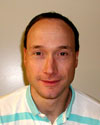 |
Plenary Talk 3
What Have We Learned so far about MIMO in Mobile Systems?
Bertrand Hochwald
Beceem Communications
Tuesday, June 23rd
9:00 - 10:00
Teatro del Pavone
Abstract
Fourth-generation mobile wireless multiuser systems such as WiMax are now being deployed with multiple-antennas at both the transmitter and receiver. These multiple-input-multiple-output (MIMO) deployments are modest in the number of antennas, typically two at the basestation and two at the mobile. We have had some time now to evaluate the effectiveness of MIMO in live mobile networks, and what have we learned? Once MIMO is enabled it is rarely turned off again. It "sells well" and performs even better. The promise of high spectral efficiencies often dominates MIMO discussions, but there are other perhaps less-obvious reasons why MIMO is is being welcomed. I will discuss what we have learned so far using field data from our deployments, and speculate on the role of MIMO in systems to come.
Biography
 Bertrand Hochwald was born in New York, NY. He received his undergraduate education from Swarthmore College, Swarthmore, PA and the M.S. in electrical engineering from Duke University, Durham, NC. From 1986 to 1989 he worked for the Department of Defense at Fort Meade, MD. In 1989 he enrolled at Yale University, New Haven, CT, where he received the M.A. in statistics and the Ph.D. in electrical engineering. In 1995-1996 he was a research associate at the Coordinated Science Laboratory, University of Illinois, Urbana-Champaign. He joined the Mathematics of Communications Research Department at Lucent Technologies Bell Laboratories in September 1996, where he became a Distinguished Member of the Technical Staff in 2002. He is now with Beceem Communications as their Chief Scientist. Bertrand Hochwald was born in New York, NY. He received his undergraduate education from Swarthmore College, Swarthmore, PA and the M.S. in electrical engineering from Duke University, Durham, NC. From 1986 to 1989 he worked for the Department of Defense at Fort Meade, MD. In 1989 he enrolled at Yale University, New Haven, CT, where he received the M.A. in statistics and the Ph.D. in electrical engineering. In 1995-1996 he was a research associate at the Coordinated Science Laboratory, University of Illinois, Urbana-Champaign. He joined the Mathematics of Communications Research Department at Lucent Technologies Bell Laboratories in September 1996, where he became a Distinguished Member of the Technical Staff in 2002. He is now with Beceem Communications as their Chief Scientist.
He is the recipient of several achievement awards while employed at the Department of Defense and the Prize Teaching Fellowship at Yale. He has served as an editor for several IEEE journals and given plenary and invited talks on various aspects of signal processing and communications. He has several patents in the field of wireless communication, and was a co-recipient of this year's Stephen O. Rice paper award from the IEEE Transactions on Communications.
|
 |

